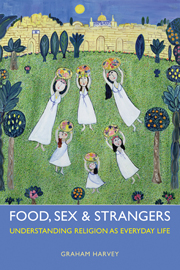Book contents
- Frontmatter
- Dedication
- Contents
- Preface
- 1 Of god and goats
- 2 Religioning elsewhere
- 3 Christianity is not a religion
- 4 Talking like a pirate
- 5 Real world
- 6 Doing violence with impunity
- 7 Respecting relations
- 8 Things full of meaning
- 9 Purity and pilgrimages
- 10 Enchantment and emplacement
- 11 Christians do religion like other people
- 12 Religion is etiquette in the real world
- Bubliography
- Index
1 - Of god and goats
- Frontmatter
- Dedication
- Contents
- Preface
- 1 Of god and goats
- 2 Religioning elsewhere
- 3 Christianity is not a religion
- 4 Talking like a pirate
- 5 Real world
- 6 Doing violence with impunity
- 7 Respecting relations
- 8 Things full of meaning
- 9 Purity and pilgrimages
- 10 Enchantment and emplacement
- 11 Christians do religion like other people
- 12 Religion is etiquette in the real world
- Bubliography
- Index
Summary
I have sometimes set my students the task of presenting ideas about where they would take visiting space aliens who ask to be shown religion. I ask them to imagine such unlikely beings saying, “We have been observing Earth and have seen sports, politics, catering, tourism and botany, but we want to observe the thing you call religion. What can you show us?” Once they get the idea, students are usually good at this. They just need to get past the idea that religion cannot be seen because it is defined as “belief in god”. Since most of my British students suppose that belief is something private, interior or personal, and that god is transcendent, neither are actually observable. My students and I find that we can do better than this. We start thinking about what people do and boldly determine to focus on religion as an everyday activity. Then we get creative. We wonder if the visiting aliens might use their senses differently and need to hear or smell religion. The competitive sonic environment of Jerusalem or the olfactory overload of temples where animals are sacrificed and incenses are wafted serve as prompts to this thought-experiment.
It is not only students who have trouble thinking about what religion might be. Many academics, even those employed to research and teach about religions, seem to find it hard to get out and see, smell, hear, taste or touch religion happening. This book might help them and their students to achieve this. It is about what we might study when we stop thinking of religion as peculiar beliefs and the strange expression of those beliefs. It seems simple enough to decide to study a particular religion (Buddhism or Paganism for example), but what is it that makes these things religions? Is Buddhism everything that Buddhists do? What about when they are washing dishes or shooting guns? Are those acts ones that scholars of religion should study or should they leave them to other people? Where can we go when we want to encounter religion? To what should we pay attention when we get there?
- Type
- Chapter
- Information
- Food, Sex and StrangersUnderstanding Religion as Everyday Life, pp. 1 - 22Publisher: Acumen PublishingPrint publication year: 2013



